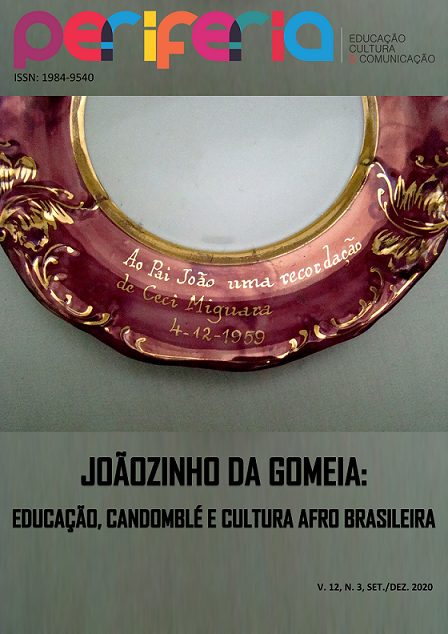Como as festas de terreiro ajudaram a construir o prestígio e o status do Rei do Candomblé Joãozinho da Goméia entre São Caetano e Duque de Caxias (1948-1971).
DOI:
https://doi.org/10.12957/periferia.2020.54835Keywords:
Joãozinho da Goméia, Festas de terreiro, NegociaçõesAbstract
João Alves Torres Filho foi o nome civil do pai de santo Joãozinho da Goméia que
construiu uma trajetória de sucesso no panteão das religiões afro-brasileiras entre 1948 e 1971. O
inicio deste caminho se dá em Salvador onde era conhecido pelo nome de João da Pedra Preta por
conta do caboclo que o inseriu nos mistérios do candomblé e o transformou em uma aclamada
liderança afro-religiosa. O intuito deste artigo é apresentar parte do projeto de ascensão social de
Pai João centrado nas festas que aconteciam no terreiro de São Caetano(Salvador) e Duque de
Caxias na Baixada Fluminense. Eram festas especificas para Iansã, Obaluaê, Oxossi; para o
Caboclo Pedra Preta e festas de saídas de Iaôs, onde o pai de santo negociava status, poder e
prestígio com chefes de polícia, delegados, militares de alta patente, políticos influentes, artistas,
gente do café soçaite carioca, lideranças candomblecistas e chefes de tendas umbandistas. Por meio
desta análise podemos exemplificar como Pai João construiu um Império religioso chamado
Goméia, e como a imprensa dá visibilidade a este Império, transformando-o em Tata Londirá, uma
realeza do panteão afro-religioso.
Downloads
Published
How to Cite
Issue
Section
License
Authors who publish in this journal agree to the following terms:
a. Authors retain the copyright and grant the journal the right of first publication, with the work simultaneously licensed under the Creative Commons Attribution License which allows the sharing of the work with acknowledgment of the authorship of the work and initial publication in this journal.
b. Authors are authorized to take additional contracts separately, for non-exclusive distribution of the version of the work published in this journal (eg, publish in institutional repository or as a book chapter), with acknowledgment of authorship and initial publication in this journal.
Authors are allowed and encouraged to publish and distribute their work online (eg in institutional repositories or on their personal page) at any point before or during the editorial process, as this can generate productive changes as well as increase the impact and the citation of the published work (See The Effect of Free Access).



